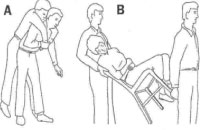Guidelines for persons with disabilities
-
Look for individuals who could personally assist you to the nearest stairwell or exit.
-
If you cannot speak loudly, carry a whistle or have some other means for attracting the attention of others.
-
It is your responsibility to prepare for emergencies by learning the location of exit corridors, stairwells, and fire alarms in each building you use frequently.
-
Tell a coworker/supervisor or classmate/instructor in each area or class if you will need assistance during an emergency evacuation from the building.
-
Practice escape routes and alternative routes.
-
Know how to help others help you. Give clear instructions as to your needs or preferences.
Evacuation Procedures
Faculty and staff are responsible for directing evacuation from their classroom and work areas. When the situation involves a person with a disability, use these guidelines to assist them:
- Know the primary and alternate evacuation routes.
- Do not move disabled persons without first asking them if they need help.
- Remain calm.
- If asked, assist the person to the nearest safe exit area on basement or upper floors this is usually the stairwell. If smoke is not present in the stairwell, assist them inside and close the fire door.
- Do not attempt to remove a disabled person from the stairwell except in extreme emergencies.
- Alert emergency personnel to the location of the person.
Use of Elevators
-
DO NOT USE the elevator during fire!
- If you do not know the nature of the emergency, assume it to be a fire.
-
If the emergency is other than fire, persons with disabilities have priority using the elevators for evacuation.
-
If you are physically able to use the stairways, you should NOT use the elevators during any emergency.
-
Visually Impaired Persons
-
Most visually impaired persons are familiar with the immediate area they are in. In the event of an emergency, tell the person the nature of the emergency and offer to guide him/her. As you walk, tell the person where you are and advise of any obstacles. When you have reached safety, orient the person to where he/she is and ask if any further assistance is needed.
Hearing Impaired Persons
Persons with impaired hearing may not perceive emergency alarms and an alternative warning technique is required. Two methods of warning are:
-
Write a note telling what the emergency is and the nearest evacuation route.
- Turn the light switch on and off. Then indicate through gestures or writing what is happening and what to do.
Persons Using Crutches, Canes or Walkers
Ask if the person needs assistance to evacuate. Offer to guide them to the emergency exit. If necessary, carrying options include using a two person lock arm position (A) or having the person sit in a sturdy chair (B), preferably one with arms. (see drawing)

Persons in Wheelchairs
There are several considerations when assisting a person in a wheelchair. Wheelchairs may have parts not intended for lifting. Batteries for life support equipment may be connected. Lifting the person could be harmful.
-
Ask the person how you can help.
- Determine if the person wants to be removed from the chair.
- Determine if the person wants to be carried down a flight of stairs; forward or backward?
- Ask what type of assistance they will need after evacuation.
- Alert emergency personnel to the location.
Learning Disabilities
Assist persons by giving them directions and orienting them to the emergency exits. Practice evacuation procedures with them prior to an emergency. Offer to guide him/her.
